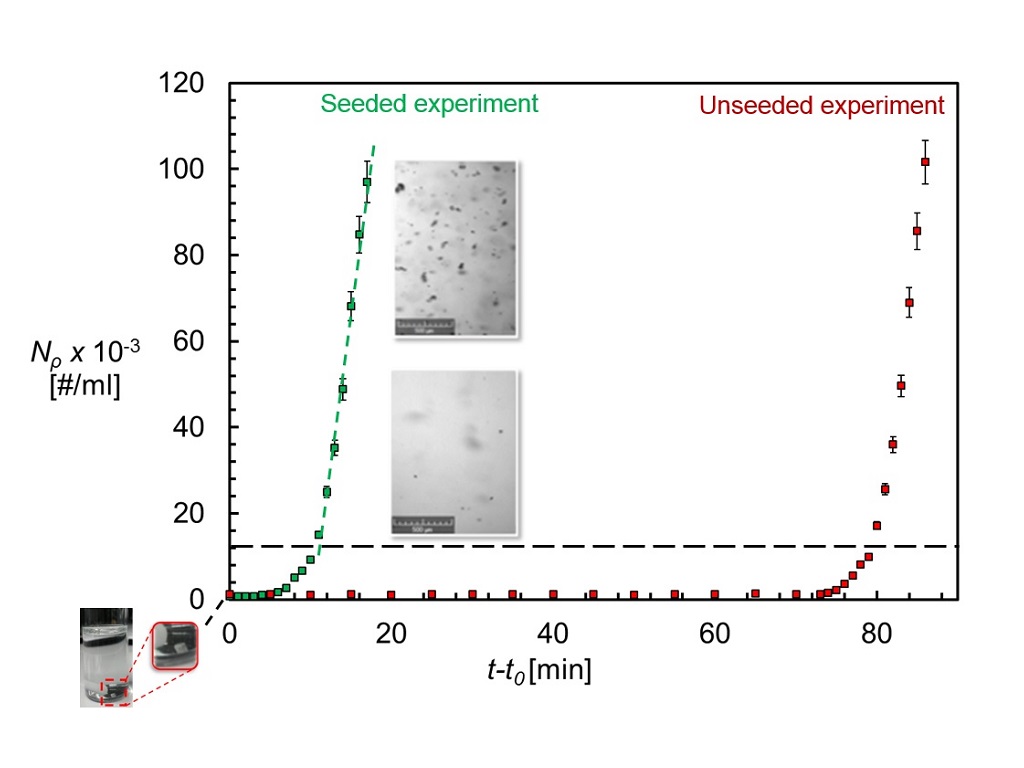Dr. Maria Briuglia (CMAC) - presentation at the Crystallization Workshop in Milan, Italy.
Nucleation is one of the key phenomena in crystallization as it initiates crystal formation in a running crystallization process and it controls particle attributions, such as polymorphism and size distribution. The rate of nucleation dictates the evolution of subsequent crystallization phenomena like crystal growth and agglomeration. Despite its importance, nucleation still remains an inadequately understood phenomenon especially in fundamental concepts.
A deep knowledge of conditions for the occurrence of specific nucleation mechanisms offers the possibility to control crystal formation. Instruments such as the Crystal16 uses clear point temperature measurements in which the temperature at which the suspension turns into a clear solution upon slowly heating the sample. Knowing the solubility is key information in designing crystallization processes and helps for instance in selecting the crystallization method.

Primary nucleation occurs in the absence of crystalline material of its own kind and is a stochastic process. The method to determine primary nucleation behavior exploits this random nature of nucleation within the Metastable Zone Width (MSZW) using probability distributions of induction time measurements [1] at constant temperature in an agitated supersaturated solution.
Did you know that the Crystal16 helps you to determine solubility curves and implicitly MSZW within 4 hours using only 100 mg of material?
First, the MSZW at different cooling rates were determined for Isonicotinamide (INA) in 1 ml ethanol solutions. This was followed by induction time measurements at isothermal conditions within the metastable zone. Subsequently, the crystal nucleation rates were determined from the obtained induction time probability distributions as a function of the applied cooling times with a minimal number of experiments. For INA in ethanol it was shown that a relation between the cooling time and the crystal nucleation rate exists. With aid of commercial equipment such as the Crystal16 such experimental induction time distributions can nowadays be routinely measured.
Secondary nucleation is the birth of new crystals in the presence of parent crystals of the same substance. It is for instance the main source for new crystals in continuous crystallization processes in continuously stirred tanks. In this part of the study, the objective was to accurately measure secondary nucleation rates while clearly distinguishing secondary and primary nucleation processes. Our approach is to seed a supersaturated solution with a known amount of well-characterized crystals under conditions at which primary nucleation does not occur. Using a single crystal seed technique the secondary nucleation rate can be measured in commercially available equipment such as the Crystalline. In this method the initial increase in particle count upon single crystal seeding a supersaturated solution is monitored.
On a small scale of several ml (figure 1), a single seed crystal was added to a clear, supersaturated solution agitated at constant temperature whilst the number of crystals subsequently formed was monitored. The secondary nucleation rate was determined from the measurement of the change of the number of particles generated in the solution over time after seeding by making use of the particle vizualization and software features of Crystalline instrument..
A combined systematic study of primary and secondary nucleation will improve the nucleation understanding and lead to product control of crystallization processes. These novel procedures can easily be incorporated within crystallization workflow [2] and design procedures enabling rapid development of industrial crystallization processes.
References
- S. Jiang, J.H. ter Horst. J Cryst. Growth Des. 2011, 11, 256−261.
- C. Brown, T. McGlone, S.Yerdelen, V.Srirambhatla, F.Mabbott, R.Gurung, M.L.Briuglia, B.Ahmed, H. Polyzois, J.McGinty, F.Perciballi, D.Frysikopolous, P. MacFhionnghaile, H.Siddique, V.Raval, T.S. Harrington, A.D. Vassileiou, M. Robertson, E. Prasad, A. Johnston, B. Johnston, A. Nordon, J.S.Srai, G. Halbert, J.H. ter Horst, C.J. Price, C.D. Rielly, J. Sefcik, A.Florence. Mol. Syst. Des. Eng. 2018.
Curious to learn more?
Check out here how the Crystal16 and Crystalline instruments were used in the experiments carried by Strathclyde University and presented during th Crystallization Workshop Milan in 2018.